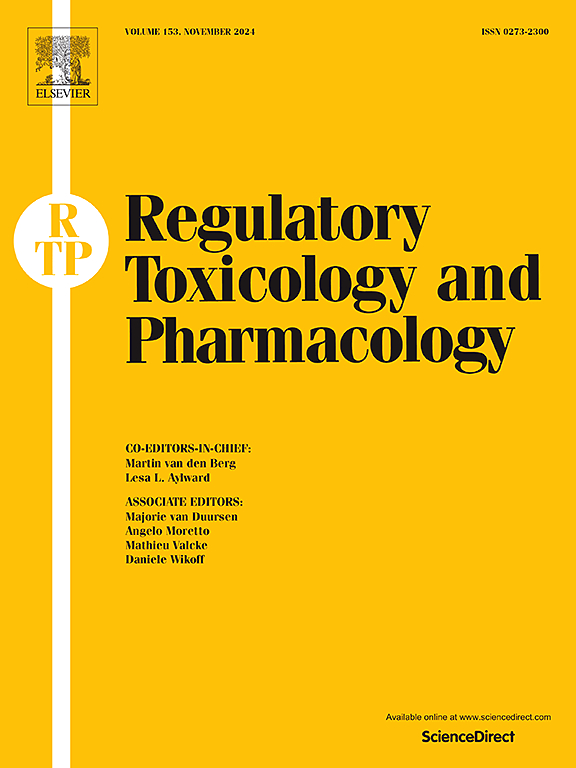Toltrazuril sulfone (Ponazuril) residue depletion in pig tissues and estimated withdrawal intervals
IF 3.5
4区 医学
Q1 MEDICINE, LEGAL
引用次数: 0
Abstract
Ponazuril (Marquis®) is a triazine based antiprotozoal medication labeled to treat equine protozoal myeloencephalitis in the United States. Ponazuril is often used in an extra-label manner to treat coccidiosis in piglets, but tissue residue data is limited. In this study, piglets were given a single oral dose of 5 mg/kg ponazuril. Piglets (n = 5) were euthanized at eleven timepoints (0, 15, 28, 43, 57, 71, 85, 99, 113, 127, and 141 days) with tissue sample collection and chromatographic analysis. The maximum residue limit (MRL) values established by the European Medicines Agency (EMA) and our laboratory limits of detection (LOD) were used as the safe levels to estimate withdrawal intervals (WDIs). Based on MRL values, the WDIs for liver, kidney, muscle and fat were approximately 72 days, 176 days, 90 days and 81 days, respectively. As this is extra-label use, any residue detected will be a violation. If the LOD was used instead of the MRL values, the WDIs would extend to as much as 130 days (liver), 270 days (kidney), 105 days (muscle), and 101 days (fat).
猪组织中托曲祖利砜(Ponazuril)残留损耗和估计停药间隔。
Ponazuril (Marquis®)是一种基于三嗪的抗原虫药物,在美国被标记为治疗马原虫性髓脑炎。Ponazuril通常以标签外的方式用于治疗仔猪球虫病,但组织残留数据有限。在本研究中,仔猪被给予单次口服剂量5 mg/kg的ponazuril。在0、15、28、43、57、71、85、99、113、127和141天11个时间点对5头仔猪实施安乐死,收集组织标本并进行色谱分析。使用欧洲药品管理局(EMA)建立的最大残留限量(MRL)值和我们的实验室检测限(LOD)作为安全水平来估计停药间隔(WDIs)。根据MRL值,肝脏、肾脏、肌肉和脂肪的wdi分别约为72天、176天、90天和81天。由于这是标签外使用,任何残留检测将是违规的。如果使用LOD代替MRL值,wdi将延长至130天(肝脏),270天(肾脏),105天(肌肉)和101天(脂肪)。
本文章由计算机程序翻译,如有差异,请以英文原文为准。
求助全文
约1分钟内获得全文
求助全文
来源期刊
CiteScore
6.70
自引率
8.80%
发文量
147
审稿时长
58 days
期刊介绍:
Regulatory Toxicology and Pharmacology publishes peer reviewed articles that involve the generation, evaluation, and interpretation of experimental animal and human data that are of direct importance and relevance for regulatory authorities with respect to toxicological and pharmacological regulations in society. All peer-reviewed articles that are published should be devoted to improve the protection of human health and environment. Reviews and discussions are welcomed that address legal and/or regulatory decisions with respect to risk assessment and management of toxicological and pharmacological compounds on a scientific basis. It addresses an international readership of scientists, risk assessors and managers, and other professionals active in the field of human and environmental health.
Types of peer-reviewed articles published:
-Original research articles of relevance for regulatory aspects covering aspects including, but not limited to:
1.Factors influencing human sensitivity
2.Exposure science related to risk assessment
3.Alternative toxicological test methods
4.Frameworks for evaluation and integration of data in regulatory evaluations
5.Harmonization across regulatory agencies
6.Read-across methods and evaluations
-Contemporary Reviews on policy related Research issues
-Letters to the Editor
-Guest Editorials (by Invitation)

 求助内容:
求助内容: 应助结果提醒方式:
应助结果提醒方式:


